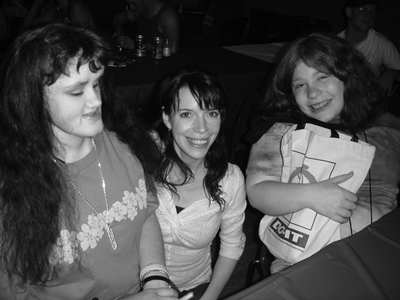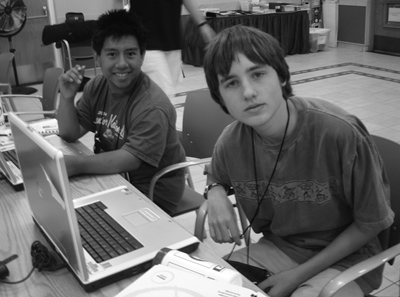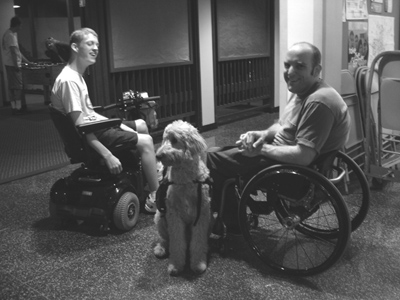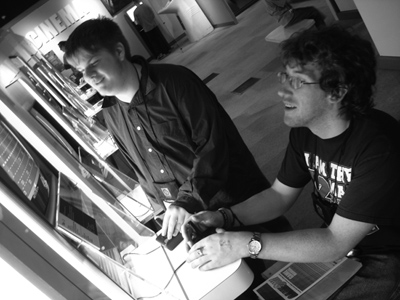Summer Study '06: What Do the Phase I Scholars Do?

DO-IT Phase I Scholars participate in a two-week, live-in Summer Study session on the University of Washington campus in Seattle, Washington. They learn about college life; surf the Internet; interact with peers, staff, and mentors; and have fun. The DO-IT Scholars program started in 1993 as an experimental project for teens with disabilities nationwide. Now it is funded for teens in Washington state by using state funds.
Below, '06 Phase I Scholars share some of their experiences. Note that, reluctantly, articles were edited by DO-IT staff to make them short enough to include in this publication, and that most are found in the online version of this issue at DO-IT News September 2006. Articles by previous Phase I Scholars can be found in earlier newsletters at DO-IT News.

Why DO-IT
by Phase I Scholars, Nicole and Maria
One might ask why a person with a disability should join DO-IT. The three main reasons for joining DO-IT Pals or DO-IT Scholars programs are:
- DO-IT helps its members get the best educational and career opportunities;
- DO-IT members share helpful information and ideas through networking; and
- DO-IT helps its members realize their full potential and learn that they can "do it!"
The DO-IT program makes sure its members have the best educational and career opportunities in many ways. First, DO-IT helps its members to receive the right level of education for them. DO-IT also helps its student members manage their high school IEPs (Individual Education Plans) and Section 504 plans to make sure they receive the necessary accommodations to fully access their educational opportunities. DO-IT provides students preparing for college with information about requesting accommodations, technology needed in college, and other helpful tips from other people with disabilities who went to or are in college.
DO-IT also makes sure its members have the best career opportunities. DO-IT helps its members obtain information about the educational requirements for the careers or fields they are interested in. DO-IT also shows its members what job opportunities are available and helps create and offer internship opportunities. DO-IT connects people with disabilities who are currently employed with students and graduates with disabilities who are trying to get a job. Additionally, DO-IT helps its members learn about the job search process, writing resumes and cover letters, and asking for accommodations in the workplace.
Another important aspect of the DO-IT program is that is helps its members connect to the Internet so they can access resources and share information. The Internet is a place for people with all types of disabilities, as well as those without, to communicate together quickly and easily. It's also a great way to get information on many topics; you can use the Internet for your homework, for example, or even to look up a person you are interested in finding out about. There are many varying ways to use the Internet, and there is something useful and helpful for everyone at every skill level. One Scholar stated that it helped her make new friends, network, and explore the interesting world of the Internet.
DO-IT also helps its members realize their full potential. There is more to life than just sitting around, watching TV, and eating. Life is amazing and the universe is full; there is always something to do! Each individual has his or her own special talent. It often takes time, dedication, and passion to distinguish that special spark in each person. Why would anybody want to take the time to find out what their special talent or spark is? I'll tell you why. Imagine going rafting down a whitewater river, with obstacles like trees and rocks everywhere, and the only way down is by rafting downstream. What do you do-go down and fight or stay there until someone picks you up and you are safe on land? If you choose to go downstream and fight it out, you may or may not get hurt, but you will come out, and you'll be so proud of yourself that you'll want to do it again or go further. That feeling of achievement is so great, and what you just faced helps prepare you for the next obstacles. This is what life is like; it is incredible, and, if you want to have those feelings of achievement and self-confidence, then go out there, face your fears, and DO-IT!
Our most sincere hope is that this article will encourage you, if you are eligible, to join the DO-IT Scholars and/or DO-IT Pals program (see www.washington.edu/doit) and to spread the word to others. We "did it," so others can "DO-IT" too!

CSI-SEATTLE: DO-IT, DID IT, DONE
by Phase I Scholars, Daniel and Tony
During our first week at Summer Study Phase I Scholars were introduced to the exciting world of forensic science. The things we learned were fascinating and out of the ordinary. Brooke Yool, a science instructor came to talk to us about the real job of a Crime Scene Investigator (CSI). We were given the opportunity to learn about being a CSI which was very different from what we had expected. The overall class was "to die for."
We started the class with a scenario in which there had been a murder involving four suspects and only one source of evidence: the blood underneath the victim's finger nails. Brooke taught us how to analyze the fake blood samples using various chemicals. These chemicals would change the texture of the blood, which would tell us what blood type the suspect had. These were then compared to the blood found underneath the victim's finger nails.
We learned a lot about forensics while listening to our instructor. We knew that it would be different from the TV shows, but we did not expect it to be quite like this. The hit series CSI depicts forensics in a very different way. The show fails to depict how complicated forensics actually is. So the next time you're watching CSI, try to think a little more about what would really happen in the investigation; we know we will.
Dorm Life 101
by Phase I Scholars, Zachary and Samuel
During Summer Study we got the opportunity to experience living at the McCarty dorms on the University of Washington campus. The dorm itself was pretty comfortable, and the management staff and upkeep at McCarty was fantastic. Living in the dorm gave us opportunities to experience being away from family, familiar surroundings and friends, to be more independent, and to make many new friends. Dorm activities were accessible to all Scholars regardless of their disability.
In a dorm, a variety of different kinds of people live together. It can be a great opportunity for people who have different communication styles or interests to get to know each other, advocate for what they need, communicate, and work out a mutually supportive and respectful relationship. It is a chance to learn about yourself and others. One of the most important keys to sharing such a small space is to learn to talk with your roommate about what works and what doesn't, and solve problems in ways that you can both live with.
DO-IT Scholars Experience the EMP
by Phase I Scholars, Alexandra and Jennifer
On July 16th, the DO-IT Phase I and II Scholars went on a field trip to the Experience Music Project, or EMP. The EMP is a museum devoted to all kinds of music. There are art galleries pertaining to music and there is a huge music lab where you are able to try different musical instruments out, and you can even record a CD! From our awesome lunch next to the Peace Fountain behind the EMP, to learning about Jimi Hendrix, to having our three minutes of fame "playing" in a rock band, we all had a good time.
Jennifer's favorite thing at the EMP was the "tower of instruments." She also liked the area set up to try out different musical instruments and was excited about learning more about music in general. Alexandra's favorite part of the EMP was the Jimi Hendrix exhibit and seeing his handwritten lyrics.
Apart from being entertaining, another important aspect of the Experience Music Project is its accessibility for people in wheelchairs and with other disabilities. For people in wheelchairs, they had elevators that went to all of the levels. There were also buttons they could push that would open doors for them automatically. Another very good thing was that it had enough room for wheelchairs to move around. Unfortunately, the EMP is not as accessible to people with hearing impairments.
It's a HIT
by Phase I Scholars, Ryan and Taylor
The Human Interface Technology, or HIT Lab was created at the University of Washington in 1989. It was developed as a facility to create and experiment with virtual reality and other similar technologies.
One of the virtual reality programs they have developed is. Snow World It's like a video game except that it is in virtual reality. In the game you are flying through a frozen, icy canyon where snowmen are throwing snowballs at you, and you can shoot snowballs back at them. There are also penguins and mammoths in the virtual landscape. The game is intended for people who are recovering from severe burns to help ease the excruciating pain they live with while healing. It has been proven to work; CAT scans of patients showed that virtual reality reduces the amount of pain signals in the brain. We think this helps the pain because, when you are using it, you feel as if you are in another world and you do not concentrate as much on what is going on in reality.
One of the other activities at the HIT Lab is virtual hand stitching, where medical personnel can practice stitching hands. This interactive activity is good for many people with disabilities because it is situated at a low enough level that everyone can reach it. This gives more people who may want to be doctors or nurses a great, accessible place to practice. Another thing that is cool about this activity is the fact that it truly is like a real hand. You can really feel the scissors going into the skin of the virtual hand, and, like the real thing, you actually have to put pressure on the scissors to make it work. For example, if you poke a whole in the hand with the needle you can actually feel the needle in the skin!
Overall, the HIT Lab was a really good experience. It is very accessible to people with disabilities; every room with a virtual reality system/program is easy to get to, and, no matter what your disabilities are, the staff find a way to get you involved with the whole program. We give the HIT Lab a 10 out of 10 for creativity and the hard work that goes into putting it all together.

Pacific Science Center Offers Adventures to DO-IT Scholars
by Phase I Scholars, K.J. and Gabe
On a Saturday, in the midst of our two-week Summer Study program, the DO-IT Scholars went and had a little fun at the Pacific Science Center. The first thing we did when we arrived was the GameOn exhibit; the exhibit was an interactive display of older arcade video games to new game systems, such as the Xbox 360. The first floor consisted of stations where we actually got to play all of the different types of game systems. The second floor had a bunch of information about how games are made and the history behind the first game systems. We were able to try out the new and the old game systems. We were very lucky to be able to experience the GameOn exhibit while it was still around; another bonus was that it was free on the day we went!
After experiencing GameOn, we went to the IMAX Theater to watch the movie Deep Blue Sea in 3D. The movie was filled with all types of sea creatures like jellyfish, sharks, sea stars, and many more. It was very interesting how the animals helped each other, even though some of them are predators and some of them are prey. For example, the sucker fish cleans the shark and in return the shark does not eat the sucker fish. Both animals benefit because the sucker fish gets food from the shark and the shark is cleaned by the sucker fish. We had a great time watching all the different animals interact.
After the movie, we ate lunch and spent time either riding a bike on a very high, elevated ring or going back to the GameOn exhibit to hit a few more video games. Then we all went to the laser dome to the see the Laser Beatles show. The show consisted of lights on the ceiling that were in sync with Beatles music. Some of the show portrayed characters, such as an owl getting a friend. Also there were lights that showed a sailor on a yellow submarine. Some of the lights showed images of the Beatles themselves. Overall, we had a fun-filled day of games, sea creatures, and the Beatles at the Pacific Science Center.
What's the DIFF?
by Phase I Scholar, Joey Hill
The DIFF is the DO-IT International Film Festival, a name chosen based on Seattle's famous international film festival (SIFF) and used to describe "movie night" at Summer Study. We watched the film Murderball, a documentary about athletes who are quadriplegic and play rugby in wheelchairs. This film actually premiered at SIFF last year and was nominated for an Academy Award for best documentary.
The other two films on the program were The Ringer, a story about Special Olympics starring Johnny Knoxville, and real Special Olympics athletes, and Robots, an animated film. Unfortunately, the evening started out a little later than expected due to some technical problems with the projector, and we only had time to view two films, Murderball and The Ringer, before it was time for us to get ready for bed. That always seems happen when you rent films-you never get to watch them all-something generally seems to come up. It's a good reminder that things don't always work out the way you may have planned or hoped, but you can still enjoy yourself!